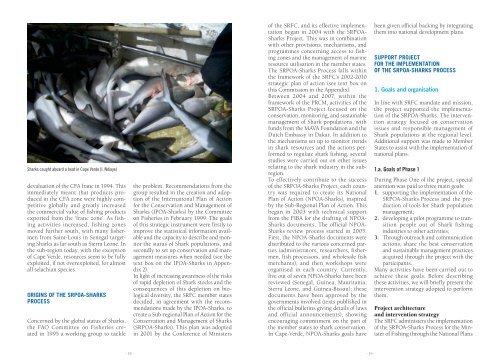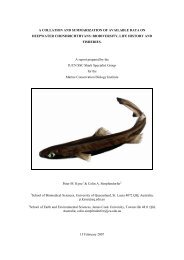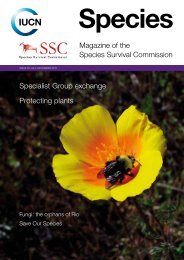30 Years of shark fishing in west africa - Shark Specialist Group
30 Years of shark fishing in west africa - Shark Specialist Group
30 Years of shark fishing in west africa - Shark Specialist Group
You also want an ePaper? Increase the reach of your titles
YUMPU automatically turns print PDFs into web optimized ePapers that Google loves.
<strong>Shark</strong>s caught aboard a boat <strong>in</strong> Cape Verde (I. Ndiaye)<br />
devaluation <strong>of</strong> the CFA franc <strong>in</strong> 1994. This<br />
immediately meant that products produced<br />
<strong>in</strong> the CFA zone were highly competitive<br />
globally and greatly <strong>in</strong>creased<br />
the commercial value <strong>of</strong> <strong>fish<strong>in</strong>g</strong> products<br />
exported from the ‘franc zone’. As <strong>fish<strong>in</strong>g</strong><br />
activities <strong>in</strong>creased, <strong>fish<strong>in</strong>g</strong> zones<br />
moved further south, with many fishermen<br />
from Sa<strong>in</strong>t-Louis <strong>in</strong> Senegal target<strong>in</strong>g<br />
<strong>Shark</strong>s as far south as Sierra Leone. In<br />
the sub-region today, with the exception<br />
<strong>of</strong> Cape Verde, resources seem to be fully<br />
exploited, if not overexploited, for almost<br />
all selachian species.<br />
Orig<strong>in</strong>s <strong>of</strong> the SRPOA-<strong>Shark</strong>s<br />
Process<br />
Concerned by the global status <strong>of</strong> <strong>Shark</strong>s,<br />
the FAO Committee on Fisheries created<br />
<strong>in</strong> 1995 a work<strong>in</strong>g group to tackle<br />
the problem. Recommendations from the<br />
group resulted <strong>in</strong> the creation and adoption<br />
<strong>of</strong> the International Plan <strong>of</strong> Action<br />
for the Conservation and Management <strong>of</strong><br />
<strong>Shark</strong>s (IPOA-<strong>Shark</strong>s) by the Committee<br />
on Fisheries <strong>in</strong> February 1999. The goals<br />
<strong>of</strong> this strategic <strong>in</strong>strument were firstly to<br />
improve the statistical <strong>in</strong>formation available<br />
and the capacity to describe and monitor<br />
the status <strong>of</strong> <strong>Shark</strong> populations, and<br />
secondly to set up conservation and management<br />
measures when needed (see the<br />
text box on the IPOA-<strong>Shark</strong>s <strong>in</strong> Appendix<br />
2).<br />
In light <strong>of</strong> <strong>in</strong>creas<strong>in</strong>g awareness <strong>of</strong> the risks<br />
<strong>of</strong> rapid depletion <strong>of</strong> <strong>Shark</strong> stocks and the<br />
consequences <strong>of</strong> this depletion on biological<br />
diversity, the SRFC member states<br />
decided, <strong>in</strong> agreement with the recommendations<br />
made by the IPOA-<strong>Shark</strong>s, to<br />
create a Sub-regional Plan <strong>of</strong> Action for the<br />
Conservation and Management <strong>of</strong> <strong>Shark</strong>s<br />
(SRPOA-<strong>Shark</strong>s). This plan was adopted<br />
<strong>in</strong> 2001 by the Conference <strong>of</strong> M<strong>in</strong>isters<br />
<strong>of</strong> the SRFC, and its effective implementation<br />
began <strong>in</strong> 2004 with the SRPOA-<br />
<strong>Shark</strong>s Project. This was <strong>in</strong> comb<strong>in</strong>ation<br />
with other provisions, mechanisms, and<br />
programmes concern<strong>in</strong>g access to <strong>fish<strong>in</strong>g</strong><br />
zones and the management <strong>of</strong> mar<strong>in</strong>e<br />
resource utilisation <strong>in</strong> the member states.<br />
The SRPOA-<strong>Shark</strong>s Process falls with<strong>in</strong><br />
the framework <strong>of</strong> the SRFC’s 2002-2010<br />
strategic plan <strong>of</strong> action (see text box on<br />
this Commission <strong>in</strong> the Appendix).<br />
Between 2004 and 2007, with<strong>in</strong> the<br />
framework <strong>of</strong> the PRCM, activities <strong>of</strong> the<br />
SRPOA-<strong>Shark</strong>s Project focused on the<br />
conservation, monitor<strong>in</strong>g, and susta<strong>in</strong>able<br />
management <strong>of</strong> <strong>Shark</strong> populations, with<br />
funds from the MAVA Foundation and the<br />
Dutch Embassy <strong>in</strong> Dakar. In addition to<br />
the mechanisms set up to monitor trends<br />
<strong>in</strong> <strong>shark</strong> resources and the actions performed<br />
to regulate <strong>shark</strong> <strong>fish<strong>in</strong>g</strong>, several<br />
studies were carried out on other issues<br />
relat<strong>in</strong>g to the <strong>shark</strong> <strong>in</strong>dustry <strong>in</strong> the subregion.<br />
To effectively contribute to the success<br />
<strong>of</strong> the SRPOA-<strong>Shark</strong>s Project, each country<br />
was required to create its National<br />
Plan <strong>of</strong> Action (NPOA-<strong>Shark</strong>s), <strong>in</strong>spired<br />
by the Sub-Regional Plan <strong>of</strong> Action. This<br />
began <strong>in</strong> 2003 with technical support<br />
from the FIBA for the draft<strong>in</strong>g <strong>of</strong> NPOA-<br />
<strong>Shark</strong>s documents. The <strong>of</strong>ficial NPOA-<br />
<strong>Shark</strong>s review process started <strong>in</strong> 2005.<br />
First, the NPOA-<strong>Shark</strong>s documents were<br />
distributed to the various concerned parties<br />
(adm<strong>in</strong>istrators, researchers, fishermen,<br />
fish processors, and wholesale fish<br />
merchants), and then workshops were<br />
organised <strong>in</strong> each country. Currently,<br />
five out <strong>of</strong> seven NPOA-<strong>Shark</strong>s have been<br />
reviewed (Senegal, Gu<strong>in</strong>ea, Mauritania,<br />
Sierra Leone, and Gu<strong>in</strong>ea-Bissau); these<br />
documents have been approved by the<br />
governments <strong>in</strong>volved (texts published <strong>in</strong><br />
the <strong>of</strong>ficial bullet<strong>in</strong>s giv<strong>in</strong>g details <strong>of</strong> laws<br />
and <strong>of</strong>ficial announcements), show<strong>in</strong>g<br />
encourag<strong>in</strong>g commitment on the part <strong>of</strong><br />
the member states to <strong>shark</strong> conservation.<br />
In Cape-Verde, NPOA-<strong>Shark</strong>s goals have<br />
been given <strong>of</strong>ficial back<strong>in</strong>g by <strong>in</strong>tegrat<strong>in</strong>g<br />
them <strong>in</strong>to national development plans.<br />
Support project<br />
for the implementation<br />
<strong>of</strong> the SRPOA-<strong>Shark</strong>s Process<br />
1. Goals and organisation<br />
In l<strong>in</strong>e with SRFC mandate and mission,<br />
the project supported the implementation<br />
<strong>of</strong> the SRPOA-<strong>Shark</strong>s. The <strong>in</strong>tervention<br />
strategy focused on conservation<br />
issues and responsible management <strong>of</strong><br />
<strong>Shark</strong> populations at the regional level.<br />
Additional support was made to Member<br />
States to assist with the implementation <strong>of</strong><br />
national plans.<br />
1.a. Goals <strong>of</strong> Phase 1<br />
Dur<strong>in</strong>g Phase One <strong>of</strong> the project, special<br />
attention was paid to three ma<strong>in</strong> goals:<br />
1. support<strong>in</strong>g the implementation <strong>of</strong> the<br />
SRPOA-<strong>Shark</strong>s Process and the production<br />
<strong>of</strong> tools for <strong>Shark</strong> population<br />
management;<br />
2. develop<strong>in</strong>g a pilot programme to transition<br />
people out <strong>of</strong> <strong>Shark</strong> <strong>fish<strong>in</strong>g</strong><br />
<strong>in</strong>dustries to other activities;<br />
3. Through outreach and communication<br />
actions, share the best conservation<br />
and susta<strong>in</strong>able management practices<br />
acquired through the project with the<br />
participants.<br />
Many activities have been carried out to<br />
achieve these goals. Before describ<strong>in</strong>g<br />
these activities, we will briefly present the<br />
<strong>in</strong>tervention strategy adopted to perform<br />
them.<br />
Project architecture<br />
and <strong>in</strong>tervention strategy<br />
The SRFC adm<strong>in</strong>isters the implementation<br />
<strong>of</strong> the SRPOA-<strong>Shark</strong>s Process for the M<strong>in</strong>ister<br />
<strong>of</strong> Fish<strong>in</strong>g through the National Plans<br />
- 18 - - 19 -
















